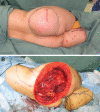Use of the Profunda Femoris Artery Perforator Flap for Reconstruction after Sarcoma Resection
- PMID: 33425601
- PMCID: PMC7787329
- DOI: 10.1097/GOX.0000000000003289
Use of the Profunda Femoris Artery Perforator Flap for Reconstruction after Sarcoma Resection
Abstract
Soft tissue sarcomas are rare neoplasms that can occur on any part of the body. The operative position for the resection is determined depending on the site of the soft tissue sarcomas; intraoperative repositioning may be needed for reconstruction. We present the profunda femoris artery perforator (PAP) flap harvest technique (wherein the flap can be used in any position), and suggest that the PAP flap transfer can eliminate the need for intraoperative repositioning.
Methods: From December 2018 to January 2020, 7 patients with an average age of 68 years underwent reconstructions using a PAP flap after wide resection of STS. The mean defect size was 11.3 × 16.5 cm (range, 5.5-25 × 11-26 cm). The location of the defects was the medial thigh in 2 patients, the posterior thigh in 1, the popliteal fossa in 1, the groin in 1, and the buttock in 2. The PAP flap was elevated in the supine "frog-leg" position, the prone position, the jack-knife position, or the lateral "crisscross" position; the lateral decubitus position with the donor lower extremity on the bottom.
Results: Of the 7 cases, the operations were performed in the supine "frog-leg" position in 3 cases, the prone position in 2 cases, the jack-knife position in 1 case, and the lateral "crisscross" position in 1 case. There were no intraoperative position changes in all cases. The mean size of the PAP flap was 8.7 × 19.9 cm (range, 6-11 × 17-24 cm). One patient had donor site dehiscence, which was treated conservatively. The PAP flaps survived completely in all cases. The mean follow-up period was 10.5 months (range, 6-17 months).
Conclusion: Since the PAP flap elevation is feasible in every position, the PAP flap can be considered a versatile reconstruction option after sarcoma resection.
Copyright © 2020 The Authors. Published by Wolters Kluwer Health, Inc. on behalf of The American Society of Plastic Surgeons.
Conflict of interest statement
Figures







Similar articles
-
Profunda femoris artery perforator flap for lateral knee joint reconstruction: A report of two cases.JPRAS Open. 2022 Mar 7;32:144-149. doi: 10.1016/j.jpra.2022.02.003. eCollection 2022 Jun. JPRAS Open. 2022. PMID: 35445150 Free PMC article.
-
An anatomical study of the lymph-collecting vessels of the medial thigh and clinical applications of lymphatic vessels preserving profunda femoris artery perforator (LpPAP) flap using pre- and intraoperative indocyanine green (ICG) lymphography.J Plast Reconstr Aesthet Surg. 2020 Sep;73(9):1768-1774. doi: 10.1016/j.bjps.2020.03.023. Epub 2020 May 19. J Plast Reconstr Aesthet Surg. 2020. PMID: 32475738
-
Breast Reconstruction Using the Geometrically Modified Profunda Artery Perforator Flap From the Posteromedial Thigh Region: Combining the Benefits of Its Predecessors.Ann Plast Surg. 2016 Oct;77(4):438-44. doi: 10.1097/SAP.0000000000000619. Ann Plast Surg. 2016. PMID: 26418785 Clinical Trial.
-
The combined transverse upper gracilis and profunda artery perforator (TUGPAP) flap for breast reconstruction.Microsurgery. 2016 Jul;36(5):359-366. doi: 10.1002/micr.22459. Epub 2015 Aug 20. Microsurgery. 2016. PMID: 26440546
-
The versatility of profunda femoral artery perforator flap for oncological reconstruction after cancer resection-Clinical cases and review of literature.J Surg Oncol. 2016 Aug;114(2):193-201. doi: 10.1002/jso.24294. Epub 2016 Jul 4. J Surg Oncol. 2016. PMID: 27377593 Review.
Cited by
-
The profunda artery perforator flap for upper limb reconstruction: A case report and literature review on the flap applications in reconstruction.Microsurgery. 2022 Oct;42(7):714-721. doi: 10.1002/micr.30941. Epub 2022 Jul 25. Microsurgery. 2022. PMID: 35876622 Free PMC article. Review.
-
A Systematic Review of the Orthoplastic Approach in Adult Lower Extremity Soft Tissue Sarcoma Flap Reconstruction.J Am Acad Orthop Surg Glob Res Rev. 2024 Feb 29;8(3):e23.00290. doi: 10.5435/JAAOSGlobal-D-23-00290. eCollection 2024 Mar 1. J Am Acad Orthop Surg Glob Res Rev. 2024. PMID: 38421606 Free PMC article.
-
Multiple Flap Transfer for Multiple Local Recurrence of Soft Tissue Sarcoma.Medicina (Kaunas). 2023 Aug 18;59(8):1489. doi: 10.3390/medicina59081489. Medicina (Kaunas). 2023. PMID: 37629779 Free PMC article.
-
Lower Abdominal vs. Lateral Thigh Perforator Flaps in Microsurgical Sarcoma Reconstruction: The Aesthetics of Donor Site Matters.J Clin Med. 2024 Jun 20;13(12):3622. doi: 10.3390/jcm13123622. J Clin Med. 2024. PMID: 38930149 Free PMC article.
References
-
- Forte AJ, Oliver JD, McRae M, et al. Use of the subscapular system by maintaining unilateral decubitus placement without repositioning in microvascular free tissue transplantation. Microsurgery. 2020;40:125–129. - PubMed
-
- Angrigiani C, Grilli D, Thorne CH. The adductor flap: a new method for transferring posterior and medial thigh skin. Plast Reconstr Surg. 2001;107:1725–1731. - PubMed
-
- Allen RJ, Haddock NT, Ahn CY, et al. Breast reconstruction with the profunda artery perforator flap. Plast Reconstr Surg. 2012;129:16e–23e. - PubMed
-
- Karakawa R, Yoshimatsu H, Fuse Y, et al. The correlation of the perforators and the accessory saphenous vein in a profunda femoris artery perforator flap for additional venous anastomosis: a cadaveric study and clinical application. Microsurgery. 2020;40:200–206. - PubMed
-
- Scaglioni MF, Kuo YR, Yang JC, et al. The posteromedial thigh flap for head and neck reconstruction: anatomical basis, surgical technique, and clinical applications. Plast Reconstr Surg. 2015;136:363–375. - PubMed
LinkOut - more resources
Full Text Sources
Research Materials
